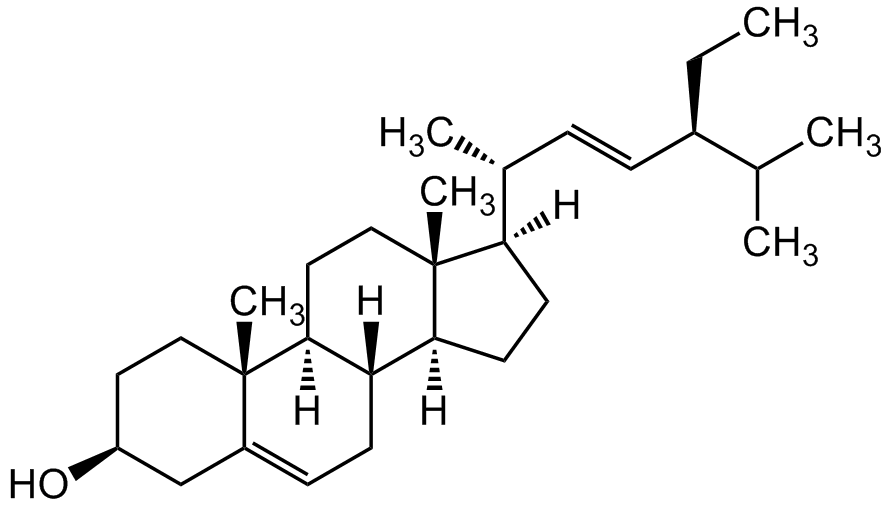Stigmasterol
| Code | Size | Price |
|---|
| CDX-S0267-G005 | 5 g | £126.00 |
Quantity:
| CDX-S0267-G010 | 10 g | £218.00 |
Quantity:
| CDX-S0267-G025 | 25 g | £487.00 |
Quantity:
Prices exclude any Taxes / VAT
Overview
Host Type: Plant
Regulatory Status: RUO
Shipping:
AMBIENT
Storage:
Short Term: +4°C, Long Term: -20°C
Images
Documents
Further Information
Alternate Names/Synonyms:
3beta-Hydroxy-24-ethyl-5,22-cholestadiene; 5,22-Stigmastadien-3beta-ol; Stigmasterin; Phytosterol; beta-Stigmasterol; Serposterol; Wulzen anti-stiffness Factor; NSC8095
Appearance:
White to off-white powder.
CAS:
83-48-7
EClass:
32160000
Form (Short):
liquid
Handling Advice:
Protect from light and moisture.
InChi:
InChI=1S/C29H48O/c1-7-21(19(2)3)9-8-20(4)25-12-13-26-24-11-10-22-18-23(30)14-16-28(22,5)27(24)15-17-29(25,26)6/h8-10,19-21,23-27,30H,7,11-18H2,1-6H3/b9-8+/t20-,21-,23+,24+,25-,26+,27+,28+,29-/m1/s1
InChiKey:
HCXVJBMSMIARIN-PHZDYDNGSA-N
Long Description:
Chemical. CAS: 83-48-7. Formula: C29H48O. MW: 412.69. Stigmasterol is a phytosterol with chemical structure similar to cholesterol and anti-hypercholestrolemic activity. It exhibits anticancer, anti-inflammatory, antioxidant, antidiabetic, neuroprotective and immune-modulating properties. Stigmasterol exhibits antitumor effects in cancer cells mediated via inhibition of cell migration, cell cycle arrest, apoptosis/autophagy induction and angiogenesis inhibition. Stigmasterol is a potent in vitro antagonist of FXR (farnesoid X receptor), a DNA polymerase beta inhibitor and targets the GLUT4 glucose transporter. It has anti-osteoarthritic effects, by decreasing the expression of matrix metalloproteinases. Stigmasterol shows acetylcholinesterase inhibitory activity and also enriched glutamatergic synapses in cultures of brain neurons. It also has been shown to have antitrypanasomal and insecticidal activity and has been used as an adjuvant for beta lactam antibiotics against beta-lactamase positive clinical isolates. Stigmasterol is also used as a precursor for synthetic progesterone and vitamin D3 and is an intermediate in the biosynthesis of androgens, estrogens and corticoids.
MDL:
MFCD00003630
Molecular Formula:
C29H48O
Molecular Weight:
412.69
Package Type:
Vial
Product Description:
Stigmasterol is a phytosterol with chemical structure similar to cholesterol and anti-hypercholestrolemic activity. It exhibits anticancer, anti-inflammatory, antioxidant, antidiabetic, neuroprotective and immune-modulating properties. Stigmasterol exhibits antitumor effects in cancer cells mediated via inhibition of cell migration, cell cycle arrest, apoptosis/autophagy induction and angiogenesis inhibition. Stigmasterol is a potent in vitro antagonist of FXR (farnesoid X receptor), a DNA polymerase beta inhibitor and targets the GLUT4 glucose transporter. It has anti-osteoarthritic effects, by decreasing the expression of matrix metalloproteinases. Stigmasterol shows acetylcholinesterase inhibitory activity and also enriched glutamatergic synapses in cultures of brain neurons. It also has been shown to have antitrypanasomal and insecticidal activity and has been used as an adjuvant for beta lactam antibiotics against beta-lactamase positive clinical isolates. Stigmasterol is also used as a precursor for synthetic progesterone and vitamin D3 and is an intermediate in the biosynthesis of androgens, estrogens and corticoids.
Purity:
>95% (HPLC)
SMILES:
O[C@H](C1)CC[C@@]2(C)C1=CC[C@]3([H])[C@]2([H])CC[C@@]4(C)[C@@]3([H])CC[C@]4([H])[C@H](C)/C=C/[C@@H](CC)C(C)C
Solubility Chemicals:
Soluble in ethanol (20mg/ml), DMF (1mg/ml) or chloroform (50 mg/ml).
Source / Host:
Plant
Transportation:
Non-hazardous
UNSPSC Category:
Natural Products/Extracts
UNSPSC Number:
12352200
Use & Stability:
Stable for at least 2 years after receipt when stored at -20°C.
References
(1) R.F. Chandler, et al.; J. Pharm. Sci. 68, 245 (1979) | (2) A.B. Awad & C.S. Fink; J. Nutr. 130, 2127 (2000) (Review) | (3) N. Antonio, et al.; Biol. Pharm. Bull. 24, 470 (2001) | (4) B.A. Carter, et al.; Pediatr. Res. 62, 301 (2007) | (5) G. Zhijie, et al.; Bioorg. Med. Chem. 16, 4331 (2008) | (6) O. Gabay, et al.; Osteoarthritis Cartilage 18, 106 (2010) | (7) Y.C. O'Callaghan, et al.; J. Agric. Food Chem. 58, 10793 (2010) | (8) S.P. Choudhary & L.S. Tran; Curr. Med. Chem. 18, 4557 (2011) (Review) | (9) N. Kaur, et al.; IJPSR 2, 2259 (2011) (Review) | (10) J.M. Brimson, et al.; Int. J. Mol. Sci. 13, 5074 (2012) | (11) S. Gade, et al.; Biochim. Biophys. Acta Gen. Subj. 1861, 541 (2017) | (12) R. Aminu, et al.; Biomed. Pharmacother. 89, 482 (2017) | (13) C.I.B. Walker, et al.; Naunyn Schmiedebergs Arch. Pharmacol. 390, 1163 (2017) | (14) J. Wang, et al.; Food Nutr. Res. 61, 1364117 (2017) | (15) T.W. Yenn, et al.; Steroids 128, 68 (2017) | (16) T. Kangsamaksin, et al.; PLoS One 12, e0189628 (2017) | (17) M.N. Haque, et al.; Nutr. Res. 56, 71 (2018) | (18) K. Li, et al.; J. BUON. 23, 1420 (2018) | (19) S.I. Aboobucker & W.P. Suza; Front. Plant Sci. 10, 354 (2019) (Review) | (20) J. Sun, et al.; Neuropsychiatr. Dis. Treat. 15, 2991 (2019)



